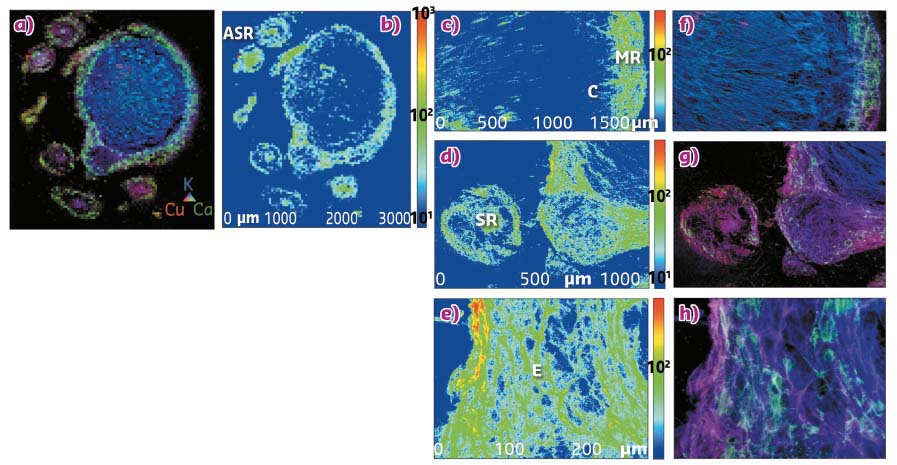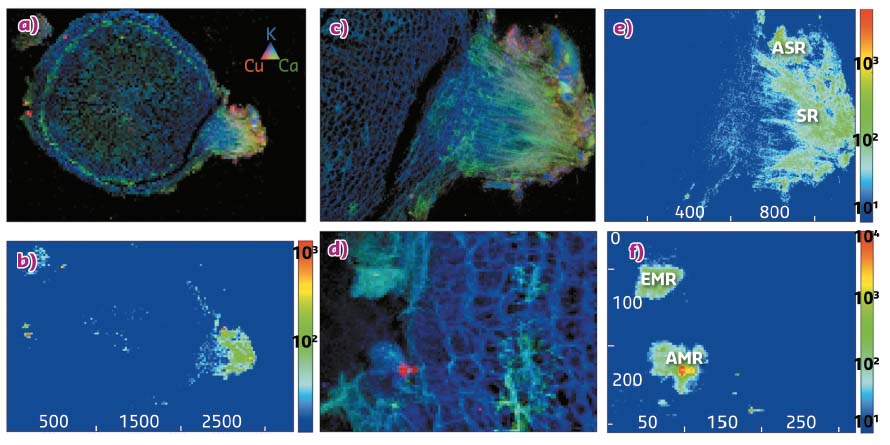- Home
- Users & Science
- Scientific Documentation
- ESRF Highlights
- ESRF Highlights 2017
- X-ray nanoprobe
- Bioaccumulation of nanoparticle CuO within a terrestrial food chain increases after weathering in soil
Bioaccumulation of nanoparticle CuO within a terrestrial food chain increases after weathering in soil
Engineered nanoparticles are additives in commercial products that we consume, apply to our skin, and use in agriculture as fertilisers and pesticides. This study examined the bioaccumulation of copper nanoparticles in lettuce and possible trophic transfer to crickets, using µ-XRF and µ-XANES to map the distribution and Cu speciation upon exposure to weathered and unweathered CuO nanoparticles.
Engineered nanoparticles have been of great interest to the agricultural sector, with the most common applications being nanofertiliser and nanopesticide products for improved crop productivity [1]. However, the fate of these materials in the environment remains poorly understood. Nanoparticles released to soil may aggregate significantly, thereby changing their size, shape and surface chemistry over time. The aging and transformation of nanoparticles in soil during weathering processes could increase or decrease particle mobility and bioavailability within terrestrial food chains. In the present study, the impact of these transformations during nanoparticle and bulk (non-nanoparticle) CuO weathering was evaluated by means of micro X-ray fluorescence (µ-XRF) and micro X-ray absorption near-edge structure (µ-XANES) spectroscopy at beamline ID21. Lettuce roots were exposed to weathered (Figure 75) and unweathered (Figure 76) CuO nanoparticles at 400 mg/kg for 70 days, following which 30 µm cross sections were analysed. Additionally, crickets fed for 15 days with lettuce exposed to weathered CuO nanoparticles were depurated for 5 days and then analysed by µ-XRF.
 |
|
Fig. 75: Images of lettuce root cross section exposed to weathered CuO nanoparticles at 400 mg/kg for 70 days. a) Tricolour µ-XRF maps of root cross sections, red colour stands for Cu, blue for K, and green for Ca. b) Cu temperature map, colour scale units are raw intensity; areas where µ-XANES was acquired from ASR: aggregate secondary root; SR: secondary root; E: epidermis; MR: main root and C: cortex are indicated. c-e) Cu temperature map of main and secondary roots, colour scale units are raw intensity. f-h) µ-XRF maps from main and secondary roots. |
The µ-XRF analysis results demonstrate that Cu was localised primarily in the main and secondary roots (Figures 75a and 76a) of the exposed lettuce plants, regardless of weathering conditions. However, the distribution of Ca was altered due to weathering in soil, showing greater distribution within the main root for the weathered treatment (green colour, Figure 75a) when compared to the unweathered treatment (green colour, Figure 76a). Additionally, a more localised and heterogeneous Cu distribution was observed in the unweathered treatment (Figure 76b) as compared to the weathered exposure, where the element was homogenously distributed within root tissue (Figure 75b).
 |
|
Fig. 76: Images of lettuce root cross section exposed to unweathered CuO nanoparticles at 400 mg/kg for 70 days. a) Tricolour µ-XRF maps of root cross sections, red colour stands for Cu, blue for K, and green for Ca. b) Cu temperature map, colour scale units are raw intensity. c, d) µ-XRF maps from main and secondary roots e, f) Cu temperature map of main and secondary roots from (c, d) µ-XRF maps, colour scale units are raw intensity. Areas where µ-XANES was acquired from ASR: aggregate secondary root; SR: secondary root; EMR: epidermis main root and AMR: aggregate main root are indicated. |
µ-XANES analysis of roots from weathered nanoparticle exposure demonstrated a significant Cu (II) reduction to Cu (I) compounds, including sulfidation, in all selected root areas (main, secondary, epidermis, cortex). Conversely, roots from unweathered nanoparticle treatments contained Cu mostly as the original CuO in multiple tissues, including the secondary and main roots. As such, µ-XANES analysis of the Cu K edge suggests that the reduction of CuO to Cu (I) complexes occurred in the soil during the weathering processes. Importantly, this reductive transformation of weathered nanoparticles correlated well with increased Cu in lettuce root tissues as measured by ICP-MS.
µ-XRF analysis from the trophic transfer study was used to localise Cu in the abdominal region of the primary consumer (cricket; A. domestica) after feeding for 15 days with lettuce exposed to weathered CuO nanoparticle treatments (data not shown). The µ-XRF results showed the homogenous distribution of P and S within the cricket’s digestive system, but Cu was not associated with the digestive tract, suggesting either absorption or elimination during the depuration period. Importantly, this study demonstrated the impact of transformation processes in soil that may result in an increased availability of chemically altered nanoparticles within terrestrial food chains.
Principal publication and authors
Weathering in soil increases nanoparticle CuO bioaccumulation within a terrestrial food chain, A.D. Servin (a), L. Pagano (a,b,c), H. Castillo-Michel (d), R. De la Torre-Roche (a), J. Hawthorne (a), J.A. Hernandez-Viezcas (a), R. Loredo-Portales (f,g), S. Majumdar (a), J. Gardea-Torresdey (e,h), O. Parkash Dhankher (b) and J.C. White (a), Nanotoxicology 11, 98-111 (2017); doi: 10.1080/17435390.2016.1277274.
(a) Department of Analytical Chemistry, Connecticut Agricultural Experiment Station, New Haven (USA)
(b) Stockbridge School of Agriculture, University of Massachusetts, Amherst (USA)
(c) Department of Life Sciences, University of Parma (Italy)
(d) ESRF
(e) Chemistry Department, University of Texas at El Paso (USA)
(f) Universidad de Guanajuato Noria Alta (Mexico)
(g) Elettra Sincrotorone Trieste, Basovizza (Italy)
(h) University of California Center for Environmental Implications of Nanotechnology (UC CEIN), El Paso (USA)
References
[1] A.D. Servin and J.C. White, NanoImpact 1, 9-12 (2016).



